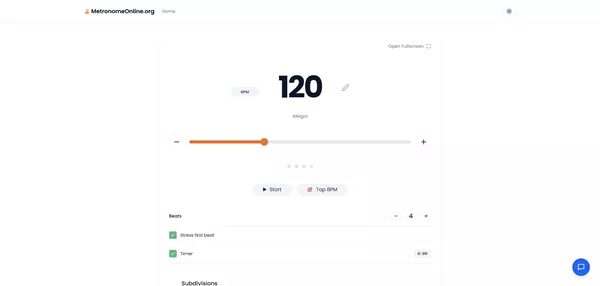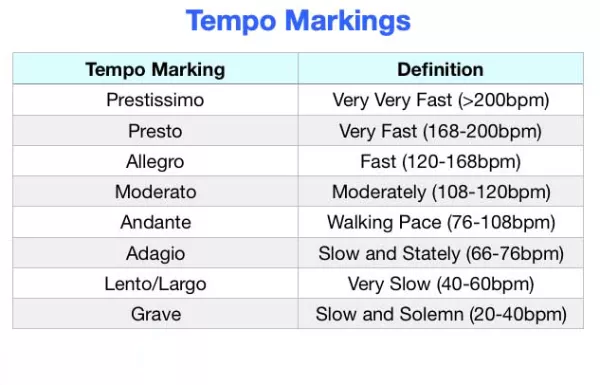Master the Beat: A Musician's Guide to Using a Metronome Online
Unlock Your Rhythmic Potential with Our Free Metronome Online
Are you a musician looking to improve your timing and learn how to practice with a metronome effectively? A metronome online is an essential tool for any musician, from beginners to professionals. It helps you develop a strong sense of rhythm, improve your timing, and build muscle memory. Should you always practice with a metronome? While it's not mandatory, incorporating a metronome into your routine can significantly enhance your musical skills. Ready to master the beat? Try our free metronome today.

Why Every Musician Needs a Metronome: The Foundation of Timing
The Importance of Rhythm in Music
Rhythm is the backbone of music. Without it, melodies lose their shape, and harmonies become muddy. A metronome is a device that produces a steady beat to help musicians maintain a consistent tempo. Whether you're practicing scales, working on a new piece, or performing live, a metronome online can be your best friend. While not always necessary, it's highly recommended for building a solid foundation in timing.

Developing a Strong Inner Clock
One of the key benefits of using a metronome is that it helps you develop a strong inner clock. This is your internal sense of timing, which allows you to play in time even without an external beat. By practicing regularly with a metronome online, you'll train your brain to recognize and maintain consistent rhythm.
Improving Timing Accuracy
A metronome provides an objective measure of your timing, allowing you to identify areas where you're rushing or dragging. By paying close attention to the beat and making adjustments as needed, you can significantly improve your accuracy and consistency.
Setting Up Your Metronome Online: BPM, Time Signatures & Subdivisions
Understanding BPM (Beats Per Minute)
BPM stands for beats per minute, and it's the standard unit of measurement for tempo. A higher BPM means a faster tempo, while a lower BPM means a slower tempo. Our metronome online allows you to adjust the BPM from 30 to 300, giving you precise control over the tempo.

Setting the Right Tempo
What should I set my metronome to? The ideal tempo depends on the piece of music you're playing and your skill level. Start with a slower tempo that allows you to play accurately, and gradually increase the BPM as you improve.
Exploring Different Time Signatures
Time signatures indicate the number of beats in each measure and the type of note that receives one beat. Common time signatures include 4/4, 3/4, and 6/8. Our metronome online allows you to experiment with different time signatures to develop your rhythmic versatility.
Subdividing Beats for Complex Rhythms
Subdividing beats means dividing each beat into smaller units, such as eighth notes or sixteenth notes. This is a useful technique for mastering complex rhythms and developing a more nuanced sense of timing. Our metronome online provides options for subdividing beats into various note values.
How to Practice Scales and Exercises with a Metronome: Building Muscle Memory
Effective Scale Practice
Practicing scales with a metronome online is a great way to improve your finger dexterity and build muscle memory. Set the metronome to a comfortable tempo and focus on playing each note evenly and accurately.

Using a Metronome for Arpeggios
Arpeggios are another essential exercise for musicians. By practicing arpeggios with a metronome, you can develop a stronger sense of timing and improve your hand coordination.
Building Finger Dexterity with Rhythmic Accuracy
Consistent practice with a metronome will help you develop the finger dexterity and rhythmic accuracy needed to play more challenging pieces of music. Remember to start slow and gradually increase the tempo as you improve.
Conquering Complex Rhythms: Using a Metronome for Advanced Techniques
Polyrhythms and Syncopation
Polyrhythms and syncopation are advanced rhythmic techniques that can add a lot of interest to your music. However, they can also be challenging to master. Using a metronome online can help you break down these complex rhythms and play them accurately.
Practicing Odd Time Signatures
Odd time signatures, such as 5/4 or 7/8, can be tricky to navigate. A metronome can be your guide, helping you keep track of the beats and maintain a steady tempo.
Developing Rhythmic Independence
Rhythmic independence is the ability to play different rhythms with different parts of your body at the same time. This is an essential skill for drummers, pianists, and other multi-instrumentalists. Practicing with a metronome online can help you develop this skill.
Metronome Hacks for Different Instruments: Guitar, Piano, Drums & More
Guitar: Chord Changes and Strumming Patterns
For guitarists, a metronome can be invaluable for improving chord changes and strumming patterns. Use the metronome online to ensure your chord changes are smooth and your strumming is even.
Piano: Coordination and Hand Independence
Pianists can use a metronome to improve coordination and hand independence. Practice playing different rhythms with each hand while keeping a steady beat with the metronome.
Drums: Groove and Fills
Drummers can use a metronome to develop a solid groove and improve their fills. Use the metronome online to practice playing in time and adding creative fills without losing the beat.
Troubleshooting Common Metronome Practice Problems: Staying on Beat
Common Mistakes and How to Avoid Them
One common mistake is rushing or dragging behind the beat. Another is not paying attention to the time signature and playing the wrong number of beats per measure. Using a metronome online and being mindful of these mistakes can help you avoid them.
Dealing with Rushing or Dragging
If you find yourself rushing or dragging, slow down the tempo and focus on playing each note precisely in time with the metronome. Try tapping your foot or counting out loud to help you stay on beat.
Adjusting Your Practice Technique
Sometimes, you may need to adjust your practice technique to get the most out of your metronome practice. Experiment with different tempos, time signatures, and subdivisions to find what works best for you.
Stay in Rhythm: Embrace the Metronome for Musical Excellence
A metronome online is more than just a tool; it's your partner in musical growth. Embrace it, use it consistently, and you'll see significant improvements in your timing, rhythm, and overall musicality. Take your first step towards rhythmic mastery today!
FAQ:
How do I choose the right BPM for my practice?
Start with a tempo that's comfortable and allows you to play accurately. Gradually increase the BPM as you improve. Experiment with different tempos to find what works best for you. Find your ideal tempo.
Should you always practice with a metronome?
While not always necessary, practicing with a metronome is highly recommended for building a solid foundation in timing and rhythm. It helps you develop a strong inner clock and improve your accuracy. See the difference.
What are the best metronome settings for 3/4 time?
For 3/4 time, set the metronome to a tempo that feels natural and comfortable. Focus on accenting the first beat of each measure. Fine-tune your 3/4 time.
Can a metronome help with ADHD or anxiety?
Some studies suggest that using a metronome may help improve focus and reduce anxiety. The steady beat can be calming and help you stay present in the moment. Enhance your focus.
How do I calculate BPM in a song?
You can calculate the BPM by counting the beats per minute in a 15-second interval and multiplying by four. Of course, you can use our TAB BPM to calculate the beat speed of a song by clicking the speed!